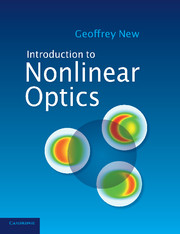Book contents
- Frontmatter
- Contents
- Preface
- Acknowledgements
- 1 Introduction
- 2 Frequency mixing
- 3 Crystal optics
- 4 Nonlinear optics in crystals
- 5 Third-order nonlinear processes
- 6 Dispersion and optical pulses
- 7 Nonlinear optics with pulses
- 8 Some quantum mechanics
- 9 Resonant effects
- 10 High harmonic generation
- Appendix A Conventions and units
- Appendix B Linear and nonlinear susceptibilities in the time and frequency domains
- Appendix C Definition of the nonlinear coefficients
- Appendix D Non-zero d elements in non-centrosymmetric crystals
- Appendix E Real fields, complex fields, and the analytic signal
- Appendix F Geometry of the grating pair
- Appendix G The paraxial wave equation
- Appendix H Useful formulae for numerical simulations
- Appendix I Useful constants
- Answers to problems
- Further Reading
- References
- Index
Appendix D - Non-zero d elements in non-centrosymmetric crystals
Published online by Cambridge University Press: 05 June 2012
- Frontmatter
- Contents
- Preface
- Acknowledgements
- 1 Introduction
- 2 Frequency mixing
- 3 Crystal optics
- 4 Nonlinear optics in crystals
- 5 Third-order nonlinear processes
- 6 Dispersion and optical pulses
- 7 Nonlinear optics with pulses
- 8 Some quantum mechanics
- 9 Resonant effects
- 10 High harmonic generation
- Appendix A Conventions and units
- Appendix B Linear and nonlinear susceptibilities in the time and frequency domains
- Appendix C Definition of the nonlinear coefficients
- Appendix D Non-zero d elements in non-centrosymmetric crystals
- Appendix E Real fields, complex fields, and the analytic signal
- Appendix F Geometry of the grating pair
- Appendix G The paraxial wave equation
- Appendix H Useful formulae for numerical simulations
- Appendix I Useful constants
- Answers to problems
- Further Reading
- References
- Index
Summary
Table D1 contains information about which d elements are non-zero for each of the 21 non-centrosymmetric crystal classes. Column 3 lists the number of independent elements for each class and (in brackets) the lower number of independents when the Kleinmann symmetry condition (KSC) applies.
Detailed information is given in column 4 where semicolons separate independent elements. Elements that are equal to others under all circumstances (in value if not in sign) are so indicated, while elements grouped within brackets are identical if the KSC applies. In a few cases (e.g. class 24) d14 = −d25, but both are zero under Kleinmann symmetry as indicated by the ‘= 0’. The rare class 29 is non-centrosymmetric, but other aspects of the symmetry force all elements of the d matrix to be zero.
Note that, in biaxial media, the mapping from the crystallographic (abc) to the physical (xyz) axes is not necessarily straightforward. It cannot be assumed that xyz → 123, which many people would take for granted. For a detailed discussion, see Sections 4.4 and 4.6, as well as Chapter 2 of Dmitriev et al. [26].
- Type
- Chapter
- Information
- Introduction to Nonlinear Optics , pp. 232 - 233Publisher: Cambridge University PressPrint publication year: 2011



